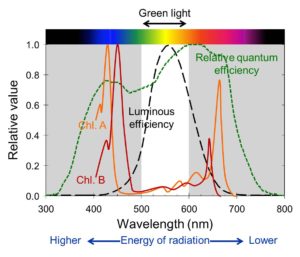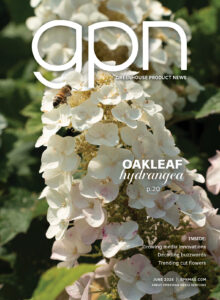Growing Plants with Green Light
Green light can be defined as radiation with wavelengths between 500 and 600 nm. Green light is within the photosynthetically active waveband of 400 to 700 nm, yet its effects on plant growth and development are not as well
understood as blue (400 to 500 nm) or red (600 to 700 nm) light. There is a somewhat common perception that green light is of little or no use to plants, but that’s simply not true.
People’s perception of green light is very good, much better than other colors of light. The luminous efficiency curve illustrates our sensitivity to the different wavelengths of light (Figure 1). From a photon perspective, sunlight emits roughly equal amounts of blue, green and red radiation. In contrast, within the photosynthetically active waveband, light emitted from conventional electric lamps (cool-white fluorescent, metal halide and high-pressure sodium) all emit 53 or 54 percent green light. This is not a coincidence; these lamps were developed for human vision and because we are so sensitive to green light, the lamps appear relatively bright to our eye.

Green light and plant growth. Many LED fixtures for plant growth applications emit mostly, or only, red and blue light. There are three primary reasons for this: 1) red and blue LEDs are more efficient than green LEDs at converting electricity into photons, 2) red and blue photons are often considered the most effective at stimulating photosynthesis on an instantaneous, single-leaf basis (see relative quantum efficiency curve, Figure 1), and 3) green light is poorly absorbed by the two types of chlorophyll when extracted in solution (also in Figure 1).
It’s true that plants appear green because leaves reflect more green light than other visible wavelengths, but typically only around 5 to 10 percent of green light is reflected, and the rest is absorbed (roughly 85 percent) or transmitted (5 to 10 percent) through the leaf. Light transmitted through one leaf is subsequently available to leaves below, so those photons are still potentially useful to plants. In addition, pigments other than chlorophyll absorb green light to make it useful for photosynthesis. Therefore, green photons are essentially as useful to plants for photosynthesis as red and blue photons.
The utility of green light in plant growth applications has been demonstrated by multiple researchers at different universities and research institutes. For example, in an experiment performed at Michigan State University, partly substituting red light for green light (resulting in 25 to 50 percent green light) reduced extension growth of seedlings, making leaves slightly smaller and stems shorter. However, plant fresh weights were similar. Under higher proportions of green, some experiments indicate that green light can actually promote extension growth, somewhat similar to the effects of far-red radiation. Therefore, the effects of green depend on its intensity, the crop and what other wavebands and intensities of light are delivered.
Green light and flowering. Flowering of plants with a photoperiodic flowering response is primarily regulated by two pigments: phytochrome and cryptochrome. Phytochrome primarily absorbs red and far-red radiation while cryptochrome primarily absorbs blue and UV-A radiation. These pigments also absorb green light, although to a much smaller degree. Because of this, one would expect green light delivered during the night (to create a long day) to be relatively ineffective at regulating flowering. However, our recent research has shown that in many plants, green light is just as effective at regulating flowering of long-day plants as the same intensity of red plus far-red radiation.
Green light and people. White light is actually a blend of blue, green and red light. In the absence of green light, for example under light from red and blue LEDs, colors appear different to us, and plants no longer appear green. One reason to include green in a plant lighting spectrum (from green LEDs or the much more efficient white LEDs) is to reduce eye strain of employees. Another reason is that without any green, it can be difficult to detect nutritional problems, physiological disorders and pest issues because of the atypical appearance of plants.









 Video Library
Video Library 


















